Organisational Behaviour: Culture, Motivation, Teams & Philosophies
VerifiedAdded on 2023/06/17
|12
|3533
|442
Report
AI Summary
This report provides an analysis of organisational behaviour, focusing on culture, politics, power, and motivation within organisations like Apple and IBM. It explores Handy's model of organisational culture, examining power, role, task, and person cultures, and their impact on individual and team performance. The report also delves into organisational politics, providing positive and negative examples, and discusses French and Raven's bases of power. Furthermore, it evaluates motivation theories, including Maslow's Need Hierarchy Theory and Vroom's expectancy theory, and their application in motivating employees. The report concludes with an examination of effective and ineffective teams, highlighting the importance of open communication and shared goals, with recommendations for IBM to foster effective teamwork. Desklib provides access to similar solved assignments and past papers for students.
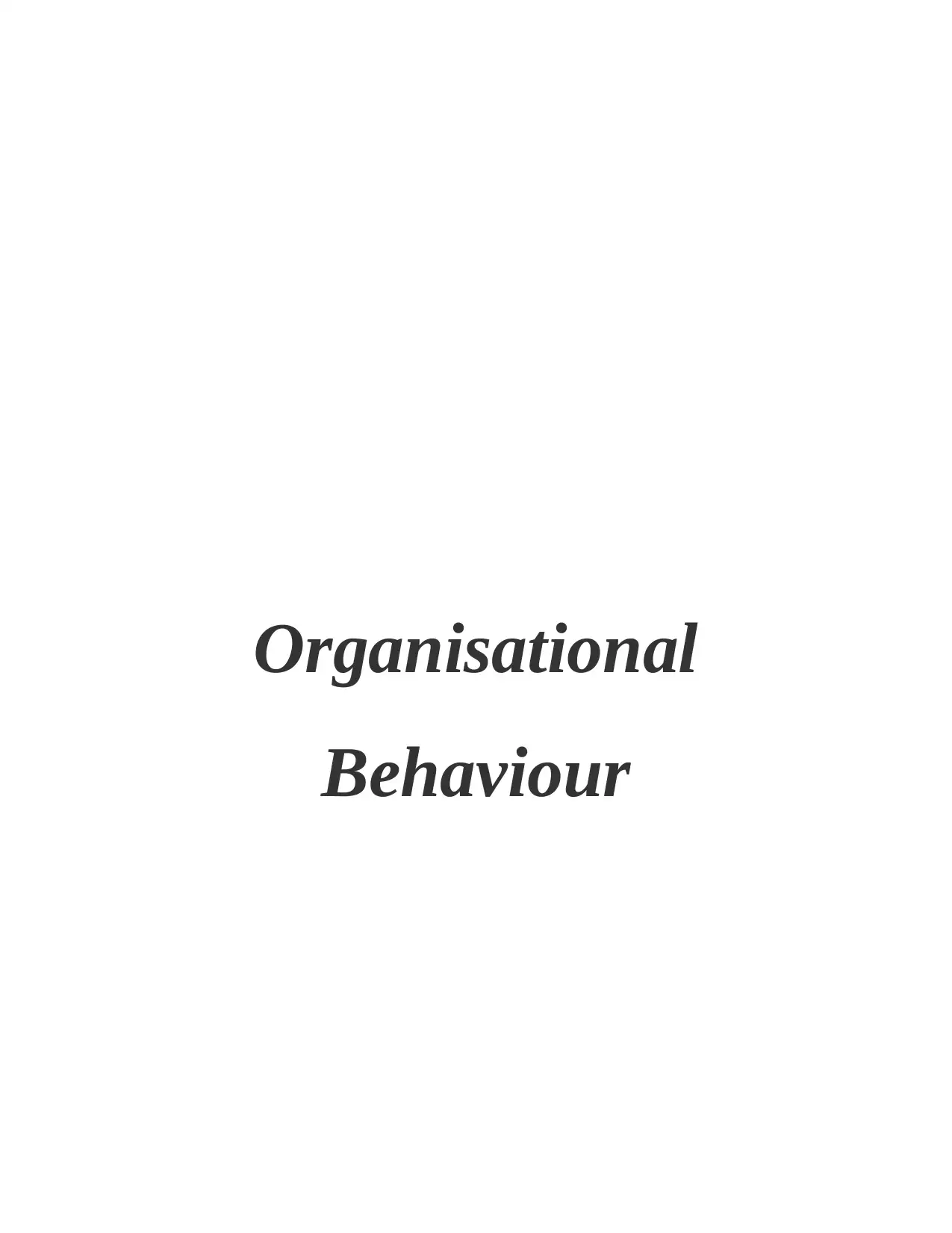
Organisational
Behaviour
Behaviour
Paraphrase This Document
Need a fresh take? Get an instant paraphrase of this document with our AI Paraphraser
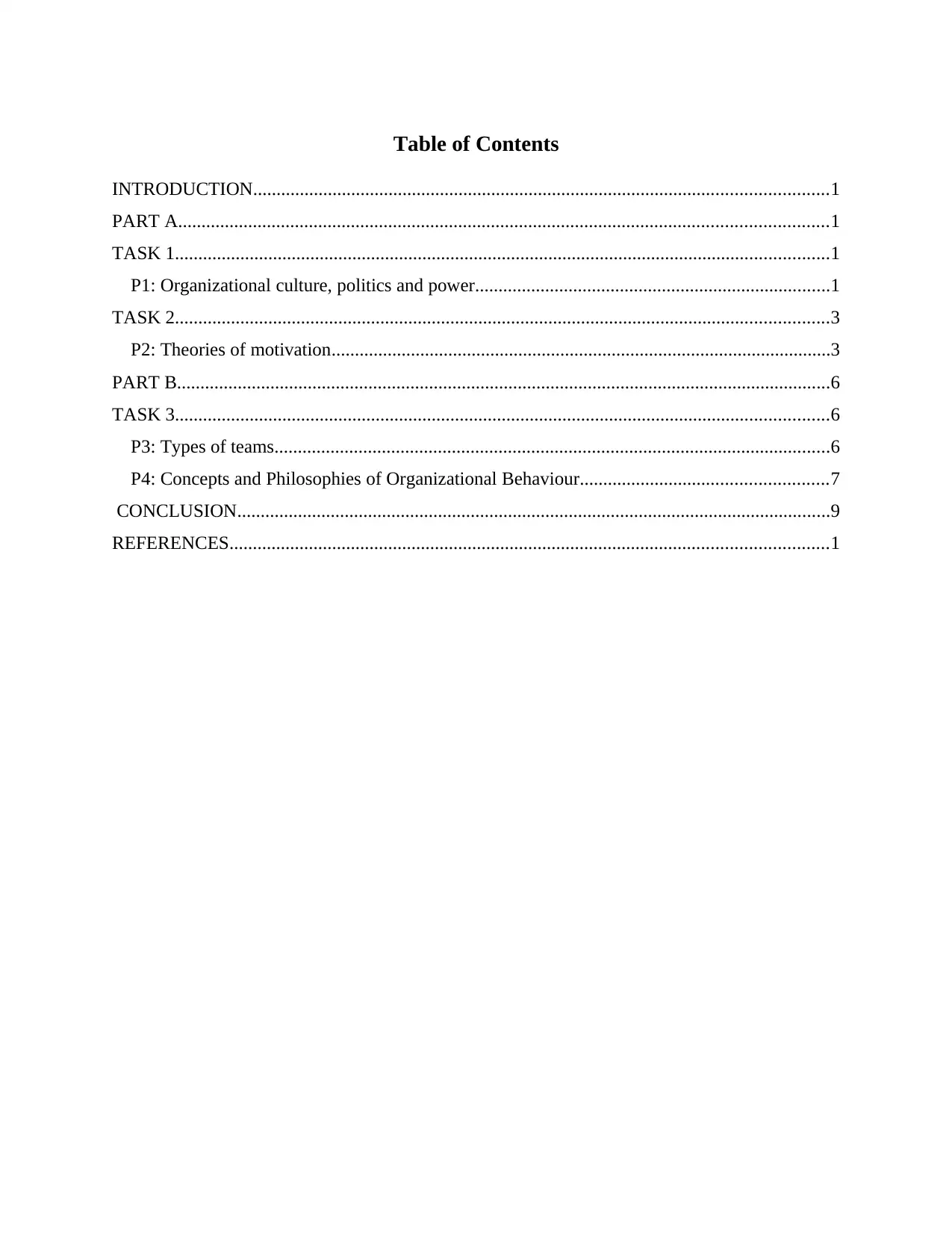
Table of Contents
INTRODUCTION...........................................................................................................................1
PART A...........................................................................................................................................1
TASK 1............................................................................................................................................1
P1: Organizational culture, politics and power............................................................................1
TASK 2............................................................................................................................................3
P2: Theories of motivation...........................................................................................................3
PART B............................................................................................................................................6
TASK 3............................................................................................................................................6
P3: Types of teams.......................................................................................................................6
P4: Concepts and Philosophies of Organizational Behaviour.....................................................7
CONCLUSION...............................................................................................................................9
REFERENCES................................................................................................................................1
INTRODUCTION...........................................................................................................................1
PART A...........................................................................................................................................1
TASK 1............................................................................................................................................1
P1: Organizational culture, politics and power............................................................................1
TASK 2............................................................................................................................................3
P2: Theories of motivation...........................................................................................................3
PART B............................................................................................................................................6
TASK 3............................................................................................................................................6
P3: Types of teams.......................................................................................................................6
P4: Concepts and Philosophies of Organizational Behaviour.....................................................7
CONCLUSION...............................................................................................................................9
REFERENCES................................................................................................................................1
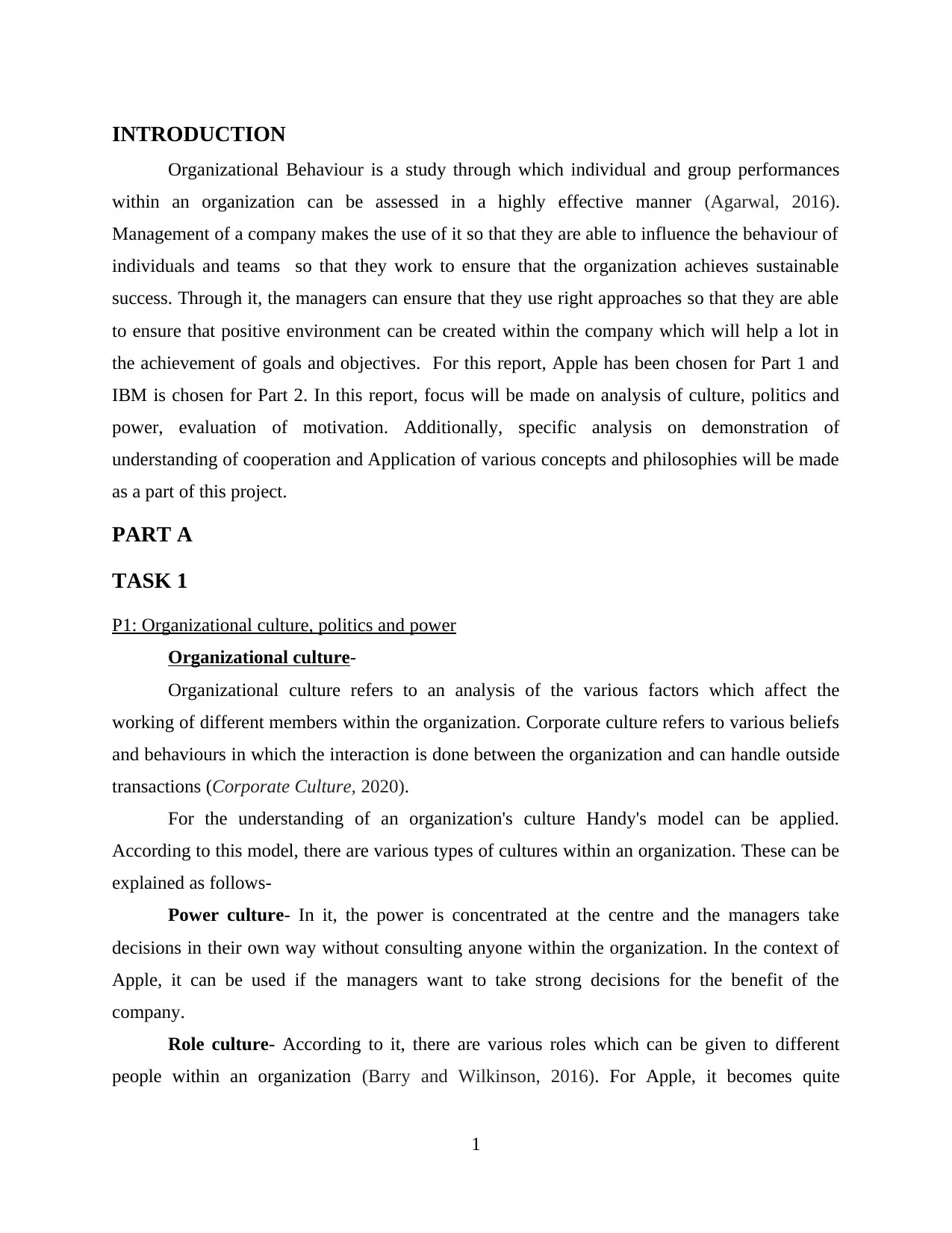
INTRODUCTION
Organizational Behaviour is a study through which individual and group performances
within an organization can be assessed in a highly effective manner (Agarwal, 2016).
Management of a company makes the use of it so that they are able to influence the behaviour of
individuals and teams so that they work to ensure that the organization achieves sustainable
success. Through it, the managers can ensure that they use right approaches so that they are able
to ensure that positive environment can be created within the company which will help a lot in
the achievement of goals and objectives. For this report, Apple has been chosen for Part 1 and
IBM is chosen for Part 2. In this report, focus will be made on analysis of culture, politics and
power, evaluation of motivation. Additionally, specific analysis on demonstration of
understanding of cooperation and Application of various concepts and philosophies will be made
as a part of this project.
PART A
TASK 1
P1: Organizational culture, politics and power
Organizational culture-
Organizational culture refers to an analysis of the various factors which affect the
working of different members within the organization. Corporate culture refers to various beliefs
and behaviours in which the interaction is done between the organization and can handle outside
transactions (Corporate Culture, 2020).
For the understanding of an organization's culture Handy's model can be applied.
According to this model, there are various types of cultures within an organization. These can be
explained as follows-
Power culture- In it, the power is concentrated at the centre and the managers take
decisions in their own way without consulting anyone within the organization. In the context of
Apple, it can be used if the managers want to take strong decisions for the benefit of the
company.
Role culture- According to it, there are various roles which can be given to different
people within an organization (Barry and Wilkinson, 2016). For Apple, it becomes quite
1
Organizational Behaviour is a study through which individual and group performances
within an organization can be assessed in a highly effective manner (Agarwal, 2016).
Management of a company makes the use of it so that they are able to influence the behaviour of
individuals and teams so that they work to ensure that the organization achieves sustainable
success. Through it, the managers can ensure that they use right approaches so that they are able
to ensure that positive environment can be created within the company which will help a lot in
the achievement of goals and objectives. For this report, Apple has been chosen for Part 1 and
IBM is chosen for Part 2. In this report, focus will be made on analysis of culture, politics and
power, evaluation of motivation. Additionally, specific analysis on demonstration of
understanding of cooperation and Application of various concepts and philosophies will be made
as a part of this project.
PART A
TASK 1
P1: Organizational culture, politics and power
Organizational culture-
Organizational culture refers to an analysis of the various factors which affect the
working of different members within the organization. Corporate culture refers to various beliefs
and behaviours in which the interaction is done between the organization and can handle outside
transactions (Corporate Culture, 2020).
For the understanding of an organization's culture Handy's model can be applied.
According to this model, there are various types of cultures within an organization. These can be
explained as follows-
Power culture- In it, the power is concentrated at the centre and the managers take
decisions in their own way without consulting anyone within the organization. In the context of
Apple, it can be used if the managers want to take strong decisions for the benefit of the
company.
Role culture- According to it, there are various roles which can be given to different
people within an organization (Barry and Wilkinson, 2016). For Apple, it becomes quite
1
⊘ This is a preview!⊘
Do you want full access?
Subscribe today to unlock all pages.

Trusted by 1+ million students worldwide
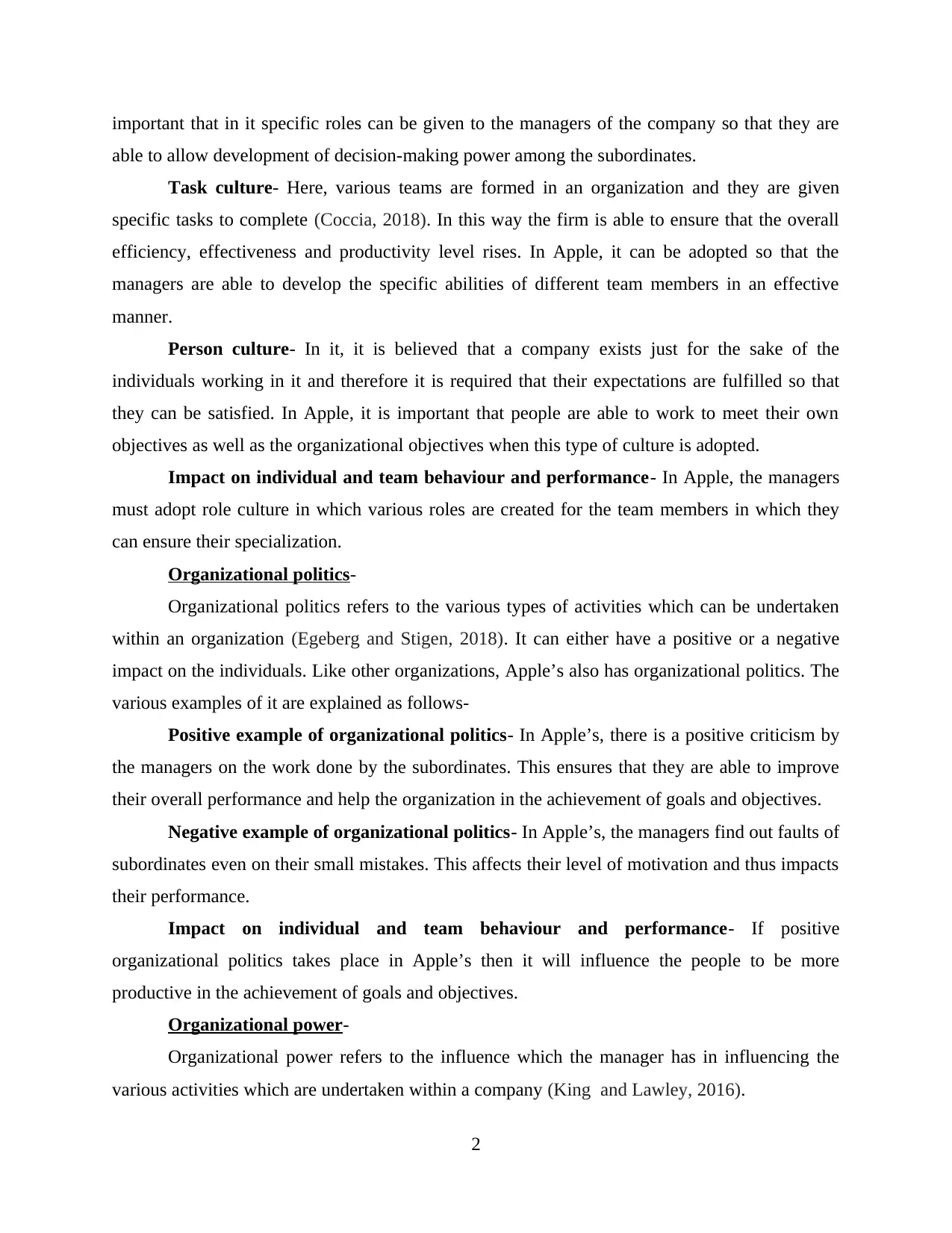
important that in it specific roles can be given to the managers of the company so that they are
able to allow development of decision-making power among the subordinates.
Task culture- Here, various teams are formed in an organization and they are given
specific tasks to complete (Coccia, 2018). In this way the firm is able to ensure that the overall
efficiency, effectiveness and productivity level rises. In Apple, it can be adopted so that the
managers are able to develop the specific abilities of different team members in an effective
manner.
Person culture- In it, it is believed that a company exists just for the sake of the
individuals working in it and therefore it is required that their expectations are fulfilled so that
they can be satisfied. In Apple, it is important that people are able to work to meet their own
objectives as well as the organizational objectives when this type of culture is adopted.
Impact on individual and team behaviour and performance- In Apple, the managers
must adopt role culture in which various roles are created for the team members in which they
can ensure their specialization.
Organizational politics-
Organizational politics refers to the various types of activities which can be undertaken
within an organization (Egeberg and Stigen, 2018). It can either have a positive or a negative
impact on the individuals. Like other organizations, Apple’s also has organizational politics. The
various examples of it are explained as follows-
Positive example of organizational politics- In Apple’s, there is a positive criticism by
the managers on the work done by the subordinates. This ensures that they are able to improve
their overall performance and help the organization in the achievement of goals and objectives.
Negative example of organizational politics- In Apple’s, the managers find out faults of
subordinates even on their small mistakes. This affects their level of motivation and thus impacts
their performance.
Impact on individual and team behaviour and performance- If positive
organizational politics takes place in Apple’s then it will influence the people to be more
productive in the achievement of goals and objectives.
Organizational power-
Organizational power refers to the influence which the manager has in influencing the
various activities which are undertaken within a company (King and Lawley, 2016).
2
able to allow development of decision-making power among the subordinates.
Task culture- Here, various teams are formed in an organization and they are given
specific tasks to complete (Coccia, 2018). In this way the firm is able to ensure that the overall
efficiency, effectiveness and productivity level rises. In Apple, it can be adopted so that the
managers are able to develop the specific abilities of different team members in an effective
manner.
Person culture- In it, it is believed that a company exists just for the sake of the
individuals working in it and therefore it is required that their expectations are fulfilled so that
they can be satisfied. In Apple, it is important that people are able to work to meet their own
objectives as well as the organizational objectives when this type of culture is adopted.
Impact on individual and team behaviour and performance- In Apple, the managers
must adopt role culture in which various roles are created for the team members in which they
can ensure their specialization.
Organizational politics-
Organizational politics refers to the various types of activities which can be undertaken
within an organization (Egeberg and Stigen, 2018). It can either have a positive or a negative
impact on the individuals. Like other organizations, Apple’s also has organizational politics. The
various examples of it are explained as follows-
Positive example of organizational politics- In Apple’s, there is a positive criticism by
the managers on the work done by the subordinates. This ensures that they are able to improve
their overall performance and help the organization in the achievement of goals and objectives.
Negative example of organizational politics- In Apple’s, the managers find out faults of
subordinates even on their small mistakes. This affects their level of motivation and thus impacts
their performance.
Impact on individual and team behaviour and performance- If positive
organizational politics takes place in Apple’s then it will influence the people to be more
productive in the achievement of goals and objectives.
Organizational power-
Organizational power refers to the influence which the manager has in influencing the
various activities which are undertaken within a company (King and Lawley, 2016).
2
Paraphrase This Document
Need a fresh take? Get an instant paraphrase of this document with our AI Paraphraser
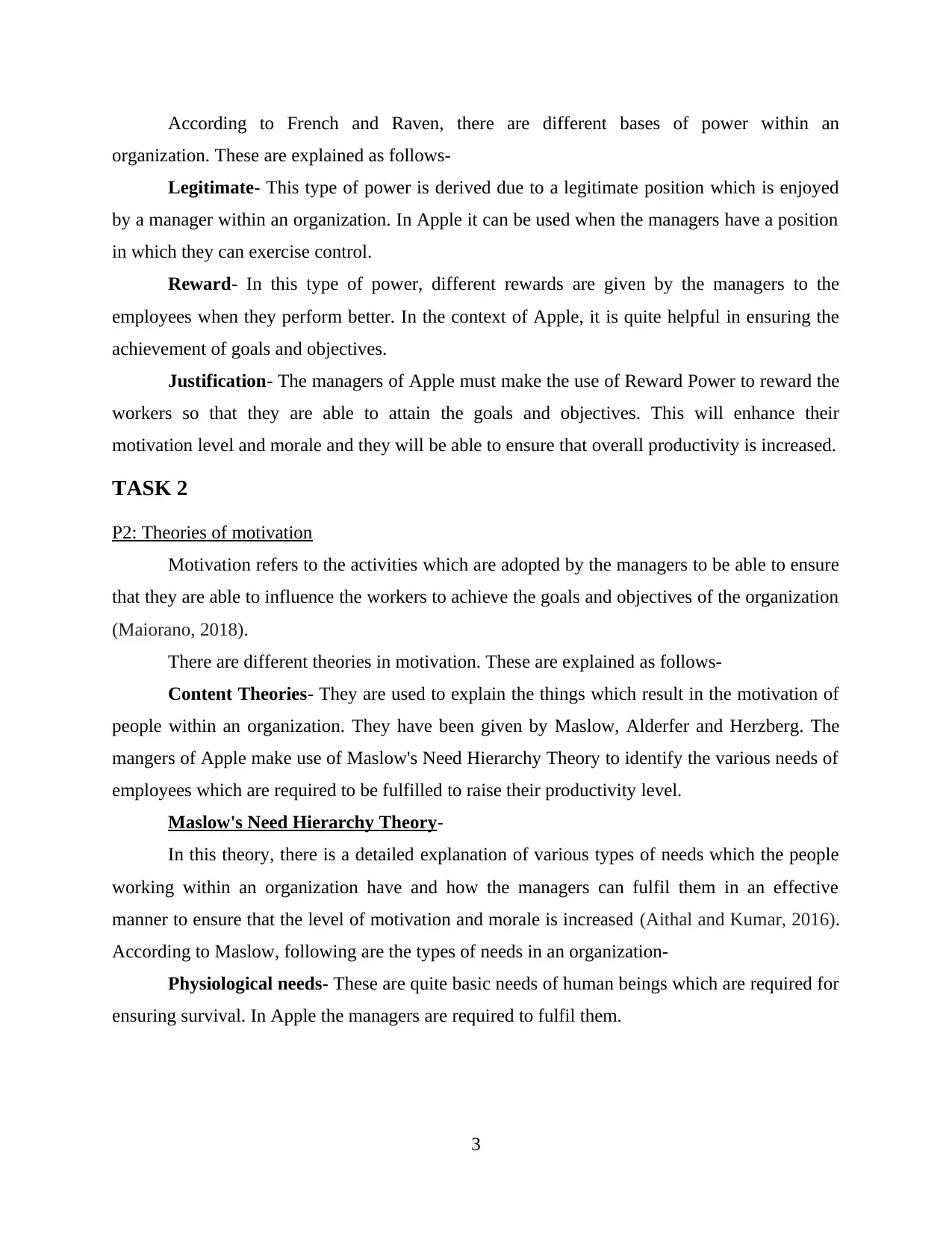
According to French and Raven, there are different bases of power within an
organization. These are explained as follows-
Legitimate- This type of power is derived due to a legitimate position which is enjoyed
by a manager within an organization. In Apple it can be used when the managers have a position
in which they can exercise control.
Reward- In this type of power, different rewards are given by the managers to the
employees when they perform better. In the context of Apple, it is quite helpful in ensuring the
achievement of goals and objectives.
Justification- The managers of Apple must make the use of Reward Power to reward the
workers so that they are able to attain the goals and objectives. This will enhance their
motivation level and morale and they will be able to ensure that overall productivity is increased.
TASK 2
P2: Theories of motivation
Motivation refers to the activities which are adopted by the managers to be able to ensure
that they are able to influence the workers to achieve the goals and objectives of the organization
(Maiorano, 2018).
There are different theories in motivation. These are explained as follows-
Content Theories- They are used to explain the things which result in the motivation of
people within an organization. They have been given by Maslow, Alderfer and Herzberg. The
mangers of Apple make use of Maslow's Need Hierarchy Theory to identify the various needs of
employees which are required to be fulfilled to raise their productivity level.
Maslow's Need Hierarchy Theory-
In this theory, there is a detailed explanation of various types of needs which the people
working within an organization have and how the managers can fulfil them in an effective
manner to ensure that the level of motivation and morale is increased (Aithal and Kumar, 2016).
According to Maslow, following are the types of needs in an organization-
Physiological needs- These are quite basic needs of human beings which are required for
ensuring survival. In Apple the managers are required to fulfil them.
3
organization. These are explained as follows-
Legitimate- This type of power is derived due to a legitimate position which is enjoyed
by a manager within an organization. In Apple it can be used when the managers have a position
in which they can exercise control.
Reward- In this type of power, different rewards are given by the managers to the
employees when they perform better. In the context of Apple, it is quite helpful in ensuring the
achievement of goals and objectives.
Justification- The managers of Apple must make the use of Reward Power to reward the
workers so that they are able to attain the goals and objectives. This will enhance their
motivation level and morale and they will be able to ensure that overall productivity is increased.
TASK 2
P2: Theories of motivation
Motivation refers to the activities which are adopted by the managers to be able to ensure
that they are able to influence the workers to achieve the goals and objectives of the organization
(Maiorano, 2018).
There are different theories in motivation. These are explained as follows-
Content Theories- They are used to explain the things which result in the motivation of
people within an organization. They have been given by Maslow, Alderfer and Herzberg. The
mangers of Apple make use of Maslow's Need Hierarchy Theory to identify the various needs of
employees which are required to be fulfilled to raise their productivity level.
Maslow's Need Hierarchy Theory-
In this theory, there is a detailed explanation of various types of needs which the people
working within an organization have and how the managers can fulfil them in an effective
manner to ensure that the level of motivation and morale is increased (Aithal and Kumar, 2016).
According to Maslow, following are the types of needs in an organization-
Physiological needs- These are quite basic needs of human beings which are required for
ensuring survival. In Apple the managers are required to fulfil them.
3
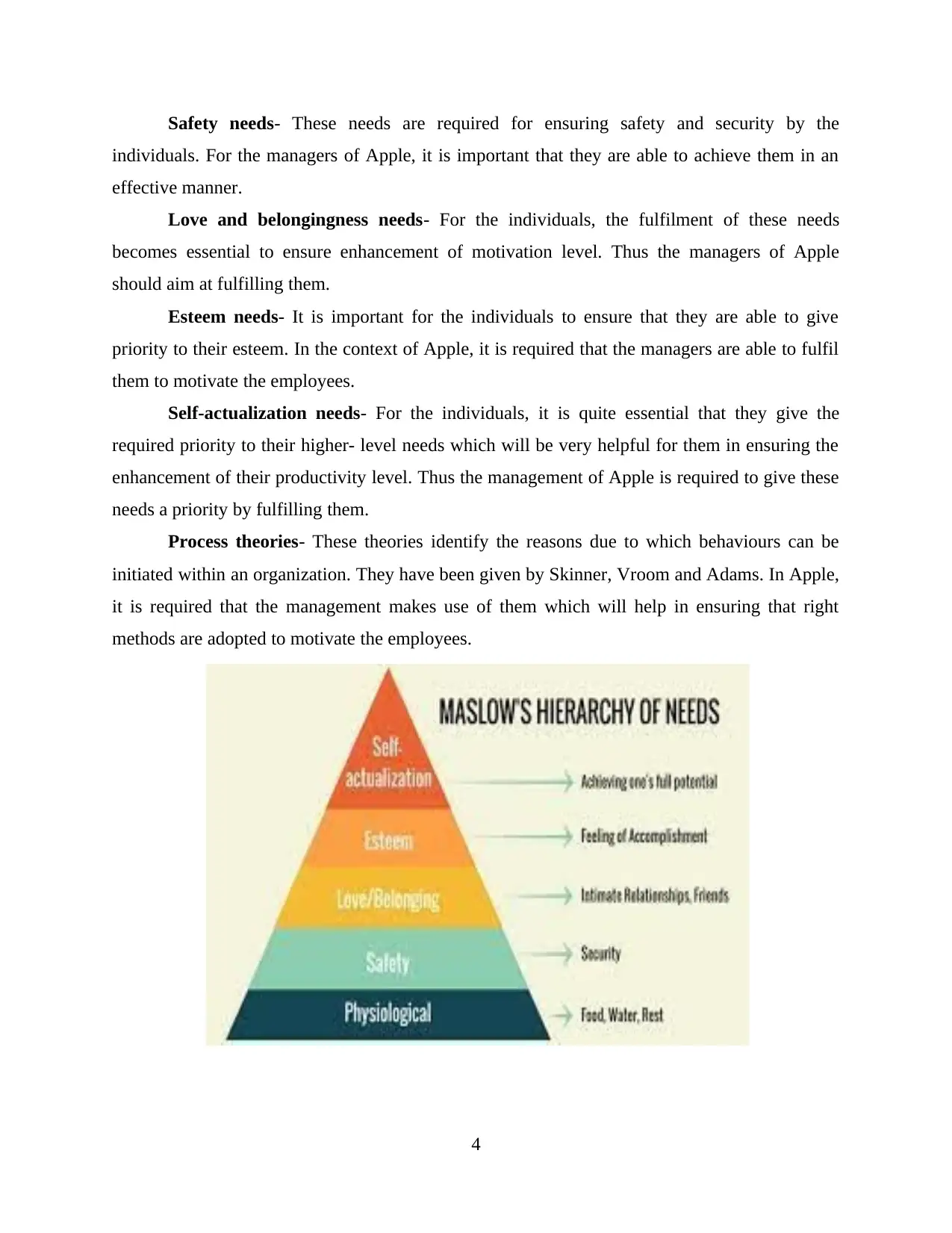
Safety needs- These needs are required for ensuring safety and security by the
individuals. For the managers of Apple, it is important that they are able to achieve them in an
effective manner.
Love and belongingness needs- For the individuals, the fulfilment of these needs
becomes essential to ensure enhancement of motivation level. Thus the managers of Apple
should aim at fulfilling them.
Esteem needs- It is important for the individuals to ensure that they are able to give
priority to their esteem. In the context of Apple, it is required that the managers are able to fulfil
them to motivate the employees.
Self-actualization needs- For the individuals, it is quite essential that they give the
required priority to their higher- level needs which will be very helpful for them in ensuring the
enhancement of their productivity level. Thus the management of Apple is required to give these
needs a priority by fulfilling them.
Process theories- These theories identify the reasons due to which behaviours can be
initiated within an organization. They have been given by Skinner, Vroom and Adams. In Apple,
it is required that the management makes use of them which will help in ensuring that right
methods are adopted to motivate the employees.
4
individuals. For the managers of Apple, it is important that they are able to achieve them in an
effective manner.
Love and belongingness needs- For the individuals, the fulfilment of these needs
becomes essential to ensure enhancement of motivation level. Thus the managers of Apple
should aim at fulfilling them.
Esteem needs- It is important for the individuals to ensure that they are able to give
priority to their esteem. In the context of Apple, it is required that the managers are able to fulfil
them to motivate the employees.
Self-actualization needs- For the individuals, it is quite essential that they give the
required priority to their higher- level needs which will be very helpful for them in ensuring the
enhancement of their productivity level. Thus the management of Apple is required to give these
needs a priority by fulfilling them.
Process theories- These theories identify the reasons due to which behaviours can be
initiated within an organization. They have been given by Skinner, Vroom and Adams. In Apple,
it is required that the management makes use of them which will help in ensuring that right
methods are adopted to motivate the employees.
4
⊘ This is a preview!⊘
Do you want full access?
Subscribe today to unlock all pages.

Trusted by 1+ million students worldwide
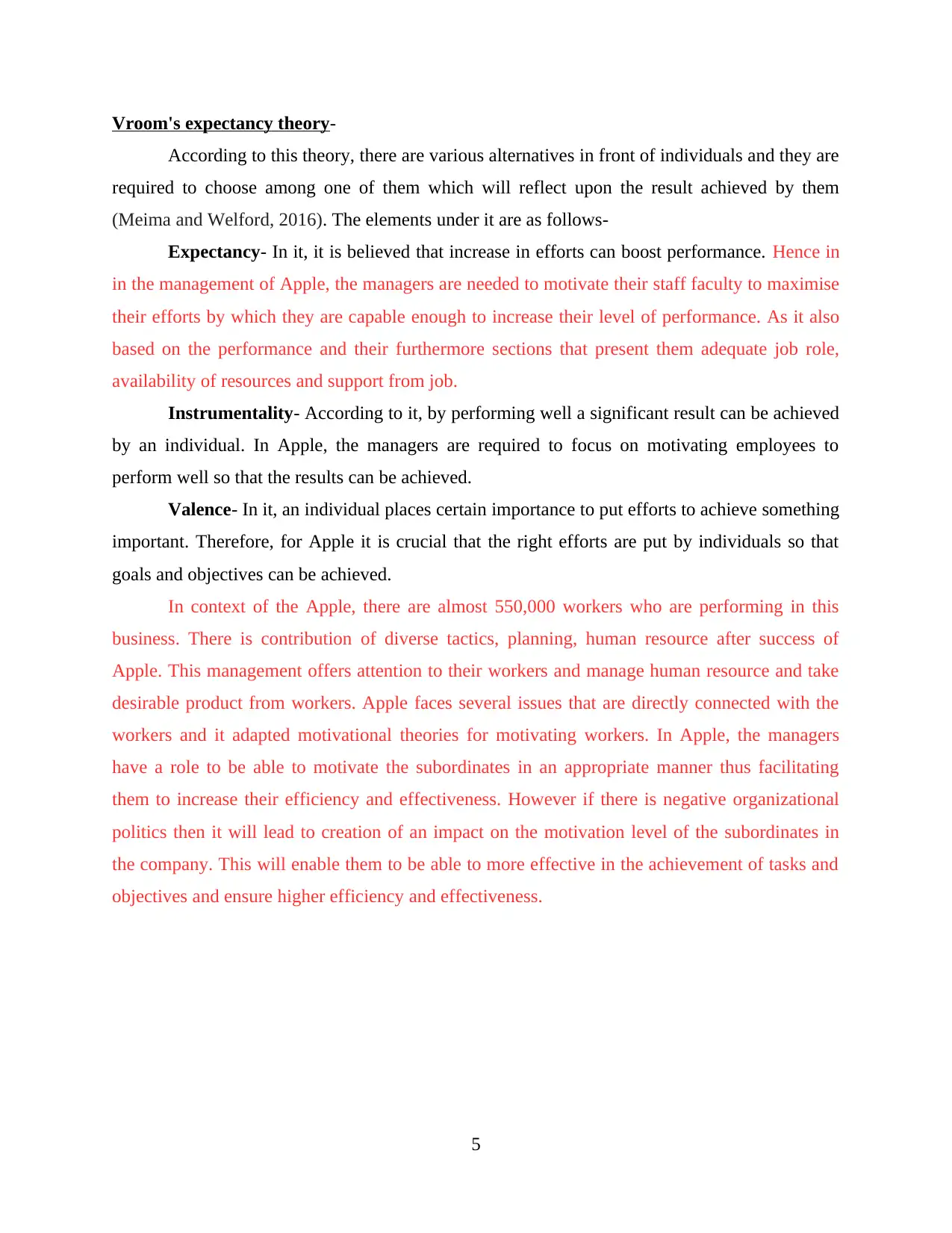
Vroom's expectancy theory-
According to this theory, there are various alternatives in front of individuals and they are
required to choose among one of them which will reflect upon the result achieved by them
(Meima and Welford, 2016). The elements under it are as follows-
Expectancy- In it, it is believed that increase in efforts can boost performance. Hence in
in the management of Apple, the managers are needed to motivate their staff faculty to maximise
their efforts by which they are capable enough to increase their level of performance. As it also
based on the performance and their furthermore sections that present them adequate job role,
availability of resources and support from job.
Instrumentality- According to it, by performing well a significant result can be achieved
by an individual. In Apple, the managers are required to focus on motivating employees to
perform well so that the results can be achieved.
Valence- In it, an individual places certain importance to put efforts to achieve something
important. Therefore, for Apple it is crucial that the right efforts are put by individuals so that
goals and objectives can be achieved.
In context of the Apple, there are almost 550,000 workers who are performing in this
business. There is contribution of diverse tactics, planning, human resource after success of
Apple. This management offers attention to their workers and manage human resource and take
desirable product from workers. Apple faces several issues that are directly connected with the
workers and it adapted motivational theories for motivating workers. In Apple, the managers
have a role to be able to motivate the subordinates in an appropriate manner thus facilitating
them to increase their efficiency and effectiveness. However if there is negative organizational
politics then it will lead to creation of an impact on the motivation level of the subordinates in
the company. This will enable them to be able to more effective in the achievement of tasks and
objectives and ensure higher efficiency and effectiveness.
5
According to this theory, there are various alternatives in front of individuals and they are
required to choose among one of them which will reflect upon the result achieved by them
(Meima and Welford, 2016). The elements under it are as follows-
Expectancy- In it, it is believed that increase in efforts can boost performance. Hence in
in the management of Apple, the managers are needed to motivate their staff faculty to maximise
their efforts by which they are capable enough to increase their level of performance. As it also
based on the performance and their furthermore sections that present them adequate job role,
availability of resources and support from job.
Instrumentality- According to it, by performing well a significant result can be achieved
by an individual. In Apple, the managers are required to focus on motivating employees to
perform well so that the results can be achieved.
Valence- In it, an individual places certain importance to put efforts to achieve something
important. Therefore, for Apple it is crucial that the right efforts are put by individuals so that
goals and objectives can be achieved.
In context of the Apple, there are almost 550,000 workers who are performing in this
business. There is contribution of diverse tactics, planning, human resource after success of
Apple. This management offers attention to their workers and manage human resource and take
desirable product from workers. Apple faces several issues that are directly connected with the
workers and it adapted motivational theories for motivating workers. In Apple, the managers
have a role to be able to motivate the subordinates in an appropriate manner thus facilitating
them to increase their efficiency and effectiveness. However if there is negative organizational
politics then it will lead to creation of an impact on the motivation level of the subordinates in
the company. This will enable them to be able to more effective in the achievement of tasks and
objectives and ensure higher efficiency and effectiveness.
5
Paraphrase This Document
Need a fresh take? Get an instant paraphrase of this document with our AI Paraphraser
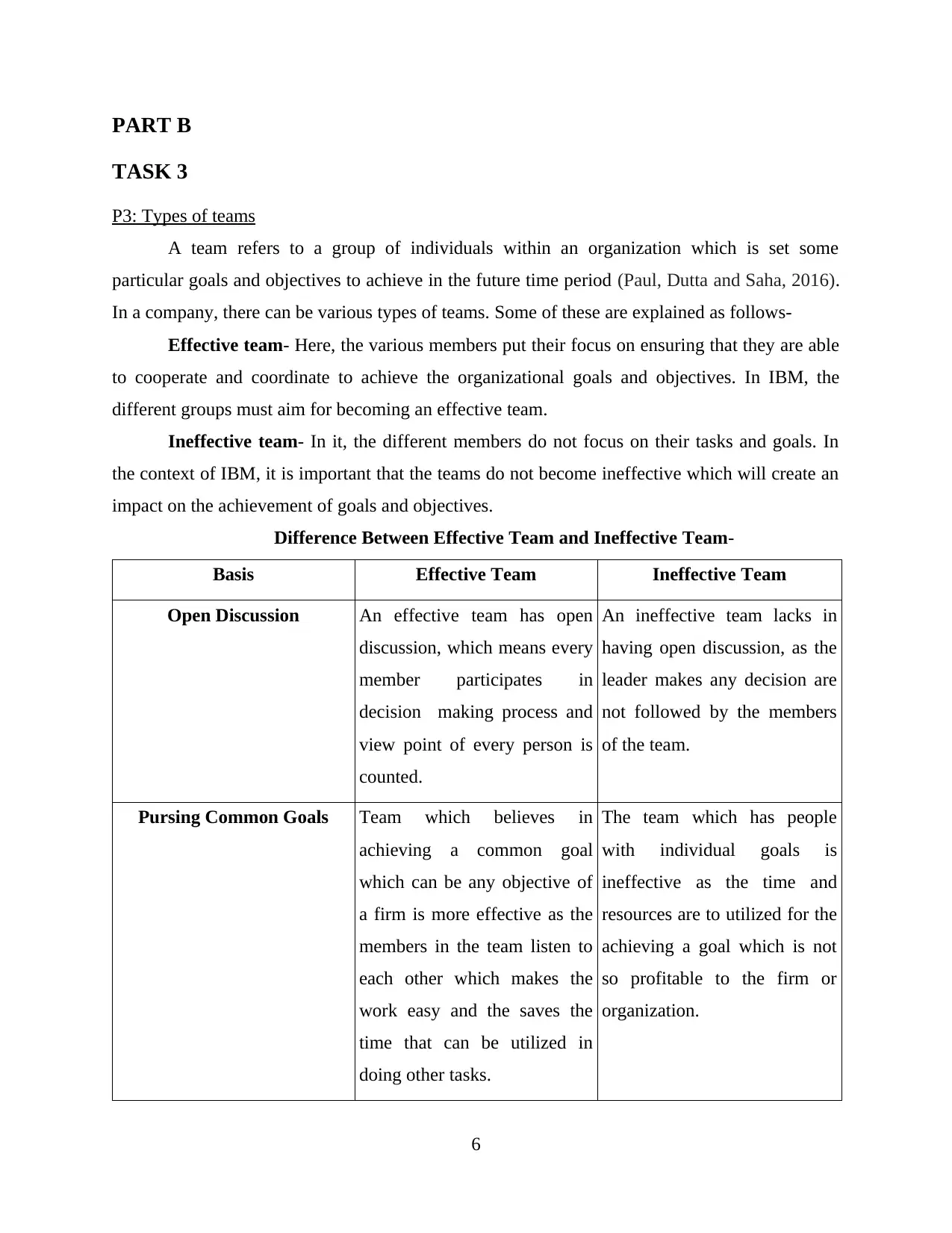
PART B
TASK 3
P3: Types of teams
A team refers to a group of individuals within an organization which is set some
particular goals and objectives to achieve in the future time period (Paul, Dutta and Saha, 2016).
In a company, there can be various types of teams. Some of these are explained as follows-
Effective team- Here, the various members put their focus on ensuring that they are able
to cooperate and coordinate to achieve the organizational goals and objectives. In IBM, the
different groups must aim for becoming an effective team.
Ineffective team- In it, the different members do not focus on their tasks and goals. In
the context of IBM, it is important that the teams do not become ineffective which will create an
impact on the achievement of goals and objectives.
Difference Between Effective Team and Ineffective Team-
Basis Effective Team Ineffective Team
Open Discussion An effective team has open
discussion, which means every
member participates in
decision making process and
view point of every person is
counted.
An ineffective team lacks in
having open discussion, as the
leader makes any decision are
not followed by the members
of the team.
Pursing Common Goals Team which believes in
achieving a common goal
which can be any objective of
a firm is more effective as the
members in the team listen to
each other which makes the
work easy and the saves the
time that can be utilized in
doing other tasks.
The team which has people
with individual goals is
ineffective as the time and
resources are to utilized for the
achieving a goal which is not
so profitable to the firm or
organization.
6
TASK 3
P3: Types of teams
A team refers to a group of individuals within an organization which is set some
particular goals and objectives to achieve in the future time period (Paul, Dutta and Saha, 2016).
In a company, there can be various types of teams. Some of these are explained as follows-
Effective team- Here, the various members put their focus on ensuring that they are able
to cooperate and coordinate to achieve the organizational goals and objectives. In IBM, the
different groups must aim for becoming an effective team.
Ineffective team- In it, the different members do not focus on their tasks and goals. In
the context of IBM, it is important that the teams do not become ineffective which will create an
impact on the achievement of goals and objectives.
Difference Between Effective Team and Ineffective Team-
Basis Effective Team Ineffective Team
Open Discussion An effective team has open
discussion, which means every
member participates in
decision making process and
view point of every person is
counted.
An ineffective team lacks in
having open discussion, as the
leader makes any decision are
not followed by the members
of the team.
Pursing Common Goals Team which believes in
achieving a common goal
which can be any objective of
a firm is more effective as the
members in the team listen to
each other which makes the
work easy and the saves the
time that can be utilized in
doing other tasks.
The team which has people
with individual goals is
ineffective as the time and
resources are to utilized for the
achieving a goal which is not
so profitable to the firm or
organization.
6
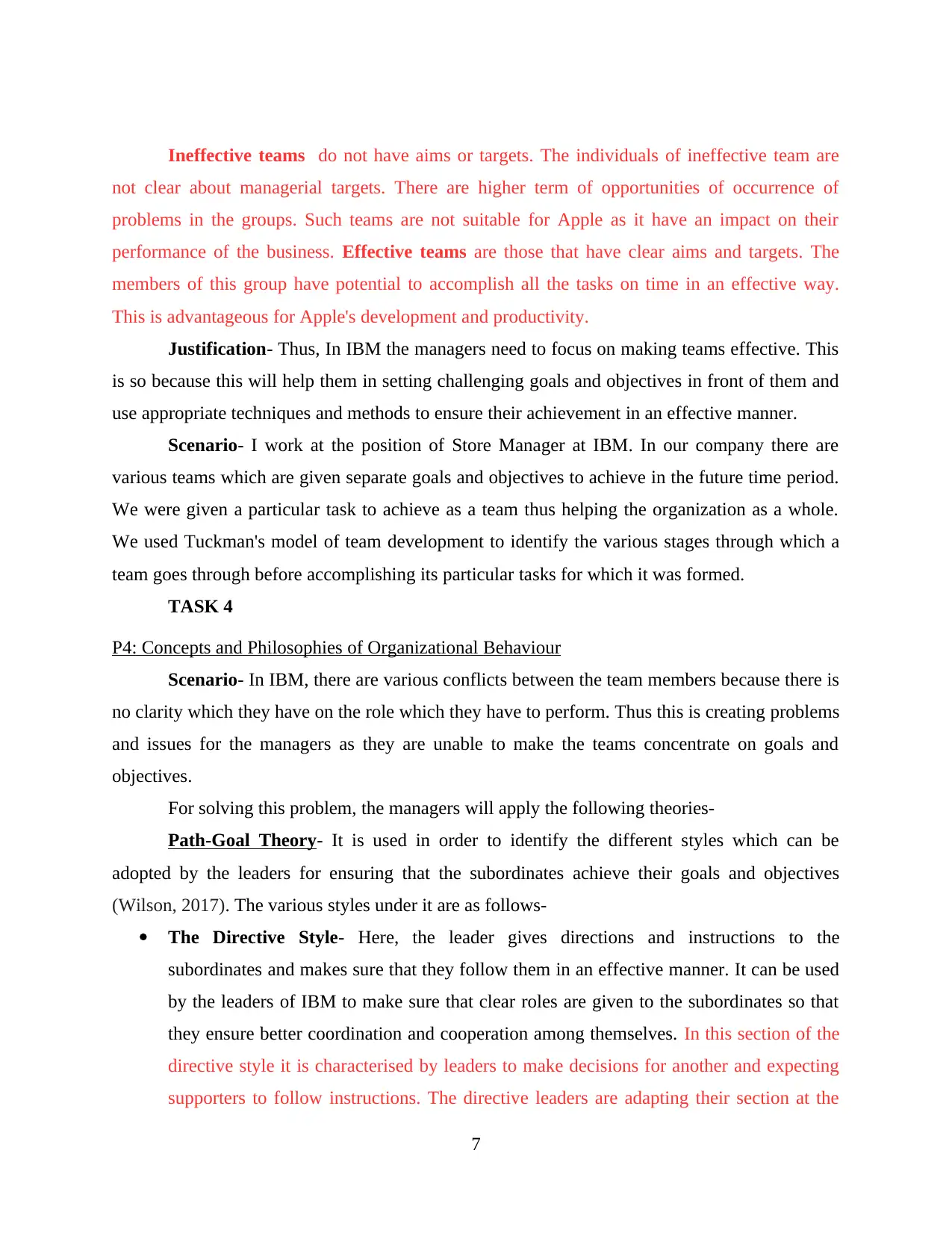
Ineffective teams do not have aims or targets. The individuals of ineffective team are
not clear about managerial targets. There are higher term of opportunities of occurrence of
problems in the groups. Such teams are not suitable for Apple as it have an impact on their
performance of the business. Effective teams are those that have clear aims and targets. The
members of this group have potential to accomplish all the tasks on time in an effective way.
This is advantageous for Apple's development and productivity.
Justification- Thus, In IBM the managers need to focus on making teams effective. This
is so because this will help them in setting challenging goals and objectives in front of them and
use appropriate techniques and methods to ensure their achievement in an effective manner.
Scenario- I work at the position of Store Manager at IBM. In our company there are
various teams which are given separate goals and objectives to achieve in the future time period.
We were given a particular task to achieve as a team thus helping the organization as a whole.
We used Tuckman's model of team development to identify the various stages through which a
team goes through before accomplishing its particular tasks for which it was formed.
TASK 4
P4: Concepts and Philosophies of Organizational Behaviour
Scenario- In IBM, there are various conflicts between the team members because there is
no clarity which they have on the role which they have to perform. Thus this is creating problems
and issues for the managers as they are unable to make the teams concentrate on goals and
objectives.
For solving this problem, the managers will apply the following theories-
Path-Goal Theory- It is used in order to identify the different styles which can be
adopted by the leaders for ensuring that the subordinates achieve their goals and objectives
(Wilson, 2017). The various styles under it are as follows-
The Directive Style- Here, the leader gives directions and instructions to the
subordinates and makes sure that they follow them in an effective manner. It can be used
by the leaders of IBM to make sure that clear roles are given to the subordinates so that
they ensure better coordination and cooperation among themselves. In this section of the
directive style it is characterised by leaders to make decisions for another and expecting
supporters to follow instructions. The directive leaders are adapting their section at the
7
not clear about managerial targets. There are higher term of opportunities of occurrence of
problems in the groups. Such teams are not suitable for Apple as it have an impact on their
performance of the business. Effective teams are those that have clear aims and targets. The
members of this group have potential to accomplish all the tasks on time in an effective way.
This is advantageous for Apple's development and productivity.
Justification- Thus, In IBM the managers need to focus on making teams effective. This
is so because this will help them in setting challenging goals and objectives in front of them and
use appropriate techniques and methods to ensure their achievement in an effective manner.
Scenario- I work at the position of Store Manager at IBM. In our company there are
various teams which are given separate goals and objectives to achieve in the future time period.
We were given a particular task to achieve as a team thus helping the organization as a whole.
We used Tuckman's model of team development to identify the various stages through which a
team goes through before accomplishing its particular tasks for which it was formed.
TASK 4
P4: Concepts and Philosophies of Organizational Behaviour
Scenario- In IBM, there are various conflicts between the team members because there is
no clarity which they have on the role which they have to perform. Thus this is creating problems
and issues for the managers as they are unable to make the teams concentrate on goals and
objectives.
For solving this problem, the managers will apply the following theories-
Path-Goal Theory- It is used in order to identify the different styles which can be
adopted by the leaders for ensuring that the subordinates achieve their goals and objectives
(Wilson, 2017). The various styles under it are as follows-
The Directive Style- Here, the leader gives directions and instructions to the
subordinates and makes sure that they follow them in an effective manner. It can be used
by the leaders of IBM to make sure that clear roles are given to the subordinates so that
they ensure better coordination and cooperation among themselves. In this section of the
directive style it is characterised by leaders to make decisions for another and expecting
supporters to follow instructions. The directive leaders are adapting their section at the
7
⊘ This is a preview!⊘
Do you want full access?
Subscribe today to unlock all pages.

Trusted by 1+ million students worldwide
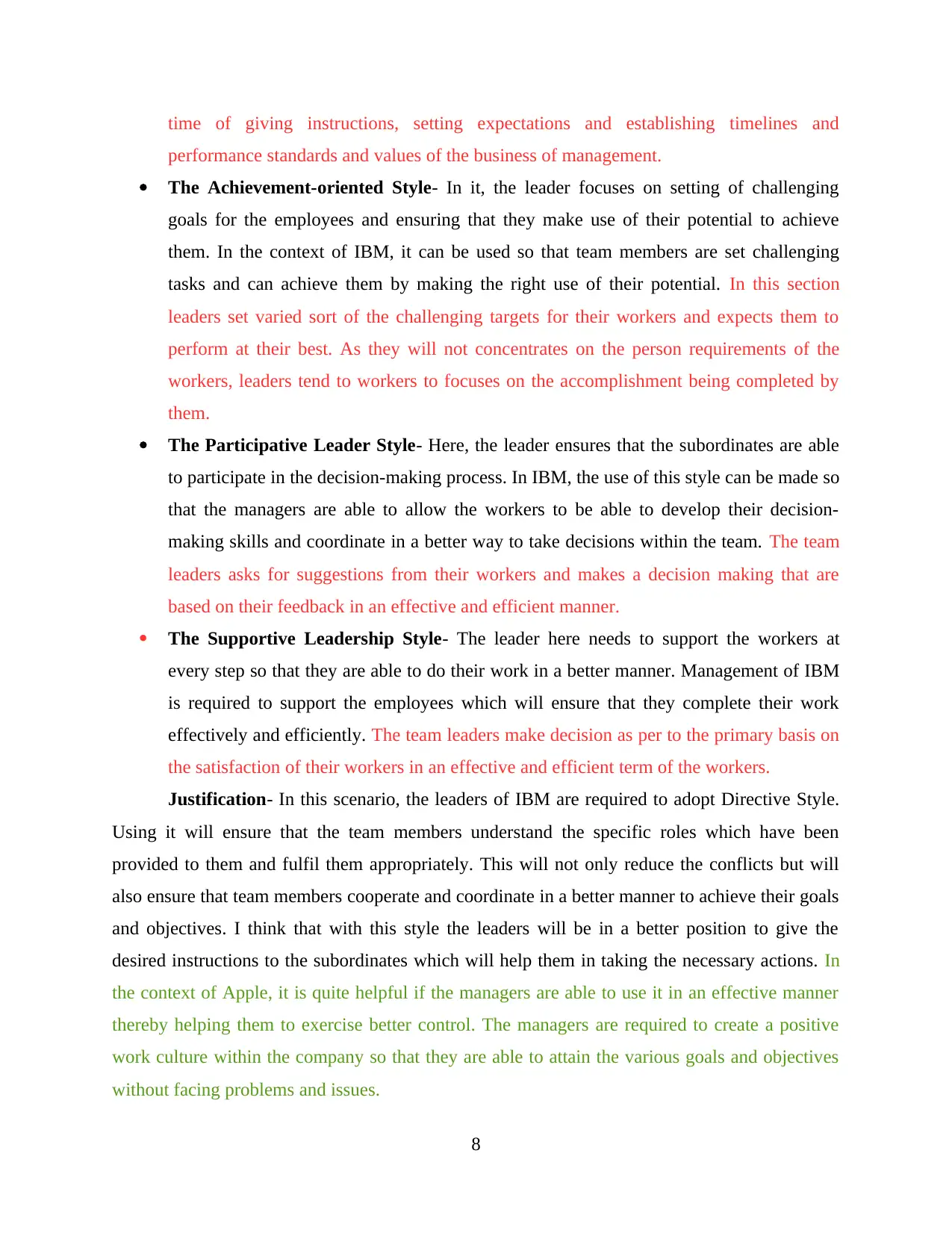
time of giving instructions, setting expectations and establishing timelines and
performance standards and values of the business of management.
The Achievement-oriented Style- In it, the leader focuses on setting of challenging
goals for the employees and ensuring that they make use of their potential to achieve
them. In the context of IBM, it can be used so that team members are set challenging
tasks and can achieve them by making the right use of their potential. In this section
leaders set varied sort of the challenging targets for their workers and expects them to
perform at their best. As they will not concentrates on the person requirements of the
workers, leaders tend to workers to focuses on the accomplishment being completed by
them.
The Participative Leader Style- Here, the leader ensures that the subordinates are able
to participate in the decision-making process. In IBM, the use of this style can be made so
that the managers are able to allow the workers to be able to develop their decision-
making skills and coordinate in a better way to take decisions within the team. The team
leaders asks for suggestions from their workers and makes a decision making that are
based on their feedback in an effective and efficient manner.
The Supportive Leadership Style- The leader here needs to support the workers at
every step so that they are able to do their work in a better manner. Management of IBM
is required to support the employees which will ensure that they complete their work
effectively and efficiently. The team leaders make decision as per to the primary basis on
the satisfaction of their workers in an effective and efficient term of the workers.
Justification- In this scenario, the leaders of IBM are required to adopt Directive Style.
Using it will ensure that the team members understand the specific roles which have been
provided to them and fulfil them appropriately. This will not only reduce the conflicts but will
also ensure that team members cooperate and coordinate in a better manner to achieve their goals
and objectives. I think that with this style the leaders will be in a better position to give the
desired instructions to the subordinates which will help them in taking the necessary actions. In
the context of Apple, it is quite helpful if the managers are able to use it in an effective manner
thereby helping them to exercise better control. The managers are required to create a positive
work culture within the company so that they are able to attain the various goals and objectives
without facing problems and issues.
8
performance standards and values of the business of management.
The Achievement-oriented Style- In it, the leader focuses on setting of challenging
goals for the employees and ensuring that they make use of their potential to achieve
them. In the context of IBM, it can be used so that team members are set challenging
tasks and can achieve them by making the right use of their potential. In this section
leaders set varied sort of the challenging targets for their workers and expects them to
perform at their best. As they will not concentrates on the person requirements of the
workers, leaders tend to workers to focuses on the accomplishment being completed by
them.
The Participative Leader Style- Here, the leader ensures that the subordinates are able
to participate in the decision-making process. In IBM, the use of this style can be made so
that the managers are able to allow the workers to be able to develop their decision-
making skills and coordinate in a better way to take decisions within the team. The team
leaders asks for suggestions from their workers and makes a decision making that are
based on their feedback in an effective and efficient manner.
The Supportive Leadership Style- The leader here needs to support the workers at
every step so that they are able to do their work in a better manner. Management of IBM
is required to support the employees which will ensure that they complete their work
effectively and efficiently. The team leaders make decision as per to the primary basis on
the satisfaction of their workers in an effective and efficient term of the workers.
Justification- In this scenario, the leaders of IBM are required to adopt Directive Style.
Using it will ensure that the team members understand the specific roles which have been
provided to them and fulfil them appropriately. This will not only reduce the conflicts but will
also ensure that team members cooperate and coordinate in a better manner to achieve their goals
and objectives. I think that with this style the leaders will be in a better position to give the
desired instructions to the subordinates which will help them in taking the necessary actions. In
the context of Apple, it is quite helpful if the managers are able to use it in an effective manner
thereby helping them to exercise better control. The managers are required to create a positive
work culture within the company so that they are able to attain the various goals and objectives
without facing problems and issues.
8
Paraphrase This Document
Need a fresh take? Get an instant paraphrase of this document with our AI Paraphraser
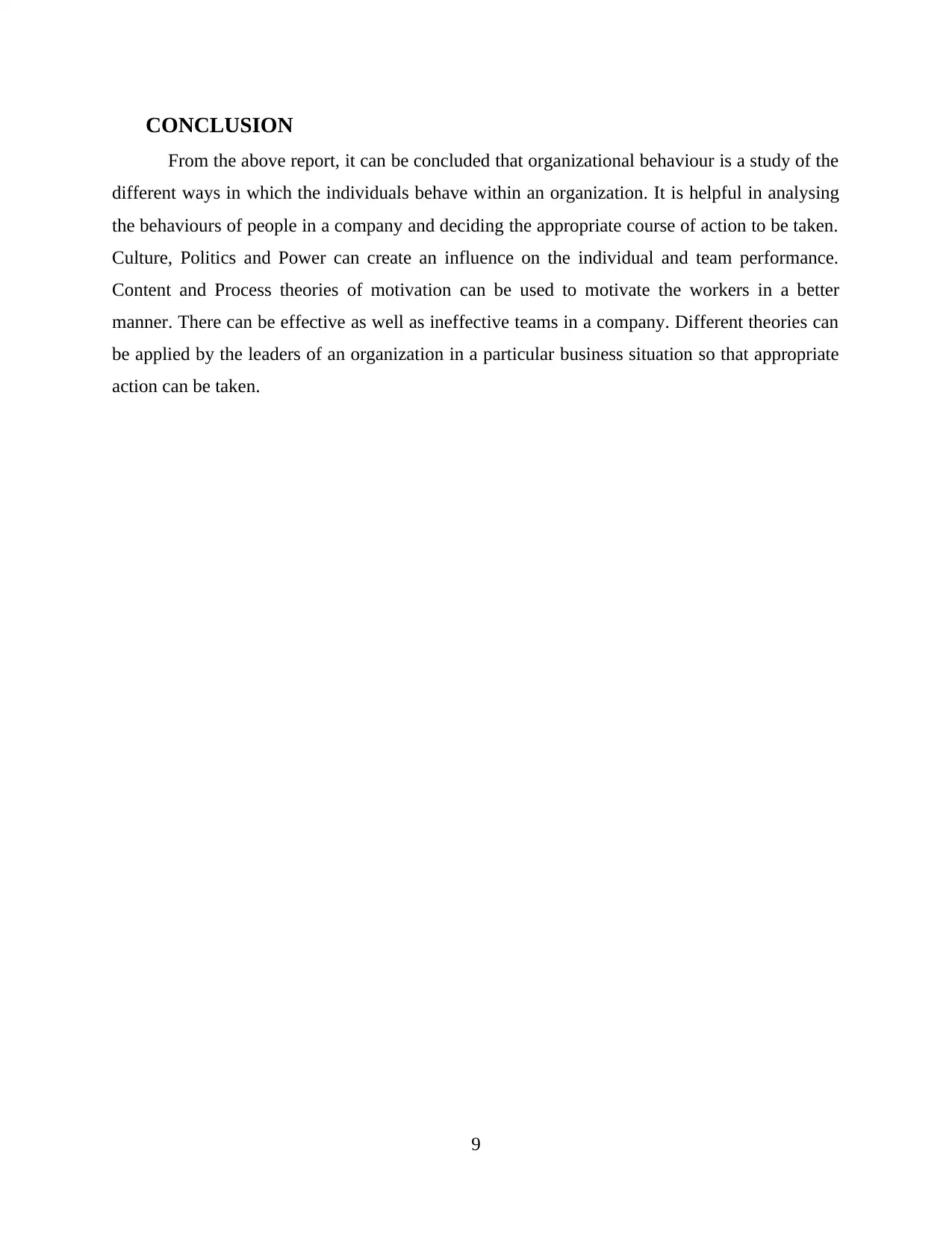
CONCLUSION
From the above report, it can be concluded that organizational behaviour is a study of the
different ways in which the individuals behave within an organization. It is helpful in analysing
the behaviours of people in a company and deciding the appropriate course of action to be taken.
Culture, Politics and Power can create an influence on the individual and team performance.
Content and Process theories of motivation can be used to motivate the workers in a better
manner. There can be effective as well as ineffective teams in a company. Different theories can
be applied by the leaders of an organization in a particular business situation so that appropriate
action can be taken.
9
From the above report, it can be concluded that organizational behaviour is a study of the
different ways in which the individuals behave within an organization. It is helpful in analysing
the behaviours of people in a company and deciding the appropriate course of action to be taken.
Culture, Politics and Power can create an influence on the individual and team performance.
Content and Process theories of motivation can be used to motivate the workers in a better
manner. There can be effective as well as ineffective teams in a company. Different theories can
be applied by the leaders of an organization in a particular business situation so that appropriate
action can be taken.
9
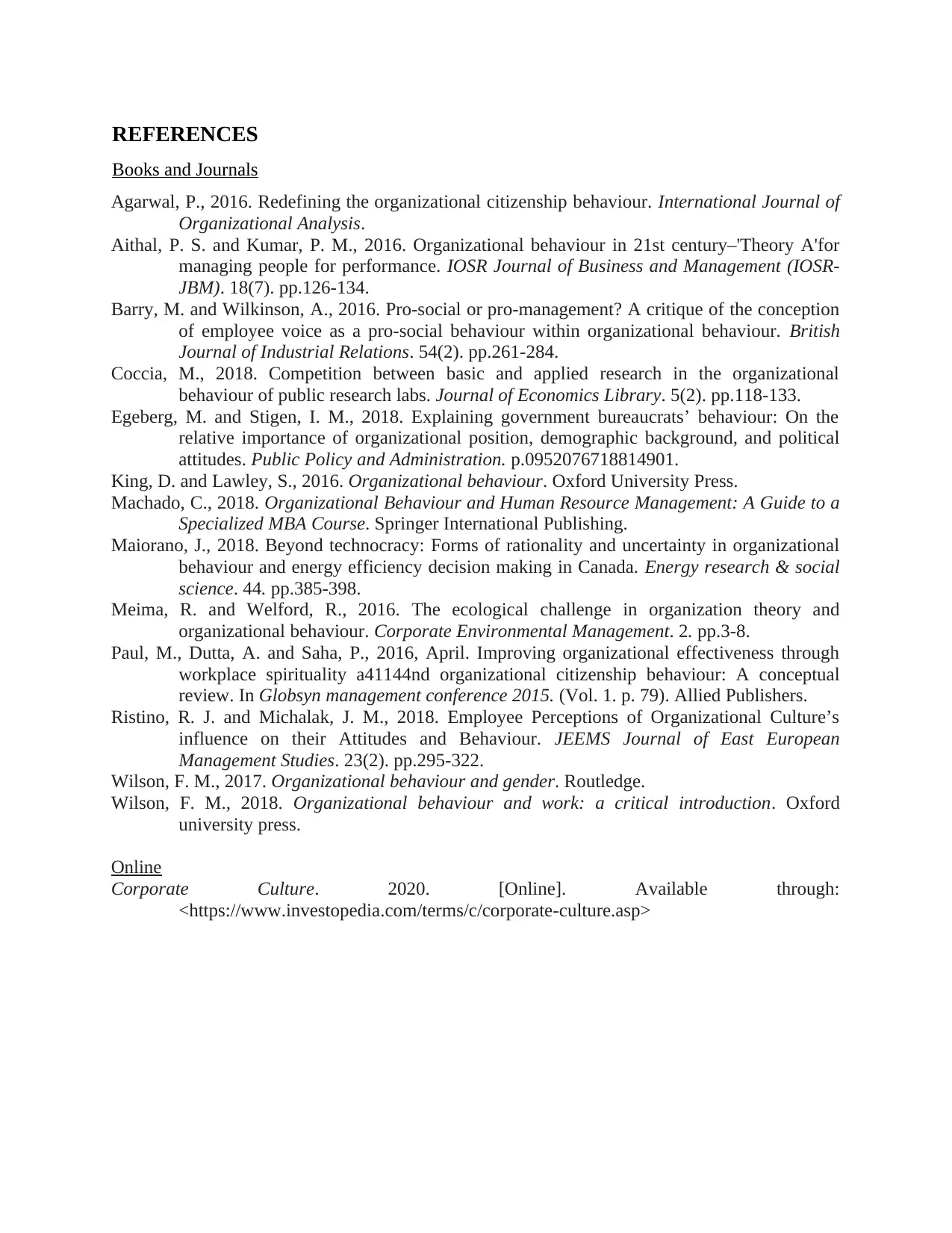
REFERENCES
Books and Journals
Agarwal, P., 2016. Redefining the organizational citizenship behaviour. International Journal of
Organizational Analysis.
Aithal, P. S. and Kumar, P. M., 2016. Organizational behaviour in 21st century–'Theory A'for
managing people for performance. IOSR Journal of Business and Management (IOSR-
JBM). 18(7). pp.126-134.
Barry, M. and Wilkinson, A., 2016. Pro‐social or pro‐management? A critique of the conception
of employee voice as a pro‐social behaviour within organizational behaviour. British
Journal of Industrial Relations. 54(2). pp.261-284.
Coccia, M., 2018. Competition between basic and applied research in the organizational
behaviour of public research labs. Journal of Economics Library. 5(2). pp.118-133.
Egeberg, M. and Stigen, I. M., 2018. Explaining government bureaucrats’ behaviour: On the
relative importance of organizational position, demographic background, and political
attitudes. Public Policy and Administration. p.0952076718814901.
King, D. and Lawley, S., 2016. Organizational behaviour. Oxford University Press.
Machado, C., 2018. Organizational Behaviour and Human Resource Management: A Guide to a
Specialized MBA Course. Springer International Publishing.
Maiorano, J., 2018. Beyond technocracy: Forms of rationality and uncertainty in organizational
behaviour and energy efficiency decision making in Canada. Energy research & social
science. 44. pp.385-398.
Meima, R. and Welford, R., 2016. The ecological challenge in organization theory and
organizational behaviour. Corporate Environmental Management. 2. pp.3-8.
Paul, M., Dutta, A. and Saha, P., 2016, April. Improving organizational effectiveness through
workplace spirituality a41144nd organizational citizenship behaviour: A conceptual
review. In Globsyn management conference 2015. (Vol. 1. p. 79). Allied Publishers.
Ristino, R. J. and Michalak, J. M., 2018. Employee Perceptions of Organizational Culture’s
influence on their Attitudes and Behaviour. JEEMS Journal of East European
Management Studies. 23(2). pp.295-322.
Wilson, F. M., 2017. Organizational behaviour and gender. Routledge.
Wilson, F. M., 2018. Organizational behaviour and work: a critical introduction. Oxford
university press.
Online
Corporate Culture. 2020. [Online]. Available through:
<https://www.investopedia.com/terms/c/corporate-culture.asp>
Books and Journals
Agarwal, P., 2016. Redefining the organizational citizenship behaviour. International Journal of
Organizational Analysis.
Aithal, P. S. and Kumar, P. M., 2016. Organizational behaviour in 21st century–'Theory A'for
managing people for performance. IOSR Journal of Business and Management (IOSR-
JBM). 18(7). pp.126-134.
Barry, M. and Wilkinson, A., 2016. Pro‐social or pro‐management? A critique of the conception
of employee voice as a pro‐social behaviour within organizational behaviour. British
Journal of Industrial Relations. 54(2). pp.261-284.
Coccia, M., 2018. Competition between basic and applied research in the organizational
behaviour of public research labs. Journal of Economics Library. 5(2). pp.118-133.
Egeberg, M. and Stigen, I. M., 2018. Explaining government bureaucrats’ behaviour: On the
relative importance of organizational position, demographic background, and political
attitudes. Public Policy and Administration. p.0952076718814901.
King, D. and Lawley, S., 2016. Organizational behaviour. Oxford University Press.
Machado, C., 2018. Organizational Behaviour and Human Resource Management: A Guide to a
Specialized MBA Course. Springer International Publishing.
Maiorano, J., 2018. Beyond technocracy: Forms of rationality and uncertainty in organizational
behaviour and energy efficiency decision making in Canada. Energy research & social
science. 44. pp.385-398.
Meima, R. and Welford, R., 2016. The ecological challenge in organization theory and
organizational behaviour. Corporate Environmental Management. 2. pp.3-8.
Paul, M., Dutta, A. and Saha, P., 2016, April. Improving organizational effectiveness through
workplace spirituality a41144nd organizational citizenship behaviour: A conceptual
review. In Globsyn management conference 2015. (Vol. 1. p. 79). Allied Publishers.
Ristino, R. J. and Michalak, J. M., 2018. Employee Perceptions of Organizational Culture’s
influence on their Attitudes and Behaviour. JEEMS Journal of East European
Management Studies. 23(2). pp.295-322.
Wilson, F. M., 2017. Organizational behaviour and gender. Routledge.
Wilson, F. M., 2018. Organizational behaviour and work: a critical introduction. Oxford
university press.
Online
Corporate Culture. 2020. [Online]. Available through:
<https://www.investopedia.com/terms/c/corporate-culture.asp>
⊘ This is a preview!⊘
Do you want full access?
Subscribe today to unlock all pages.

Trusted by 1+ million students worldwide
1 out of 12
Related Documents
Your All-in-One AI-Powered Toolkit for Academic Success.
+13062052269
info@desklib.com
Available 24*7 on WhatsApp / Email
![[object Object]](/_next/static/media/star-bottom.7253800d.svg)
Unlock your academic potential
Copyright © 2020–2025 A2Z Services. All Rights Reserved. Developed and managed by ZUCOL.





